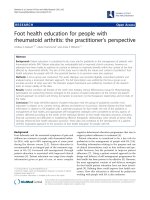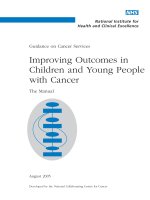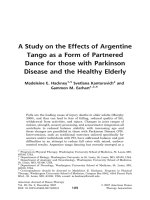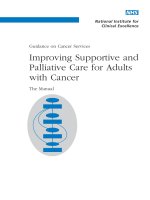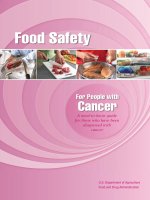Effects of group therapy for people with cancer tokyo
Bạn đang xem bản rút gọn của tài liệu. Xem và tải ngay bản đầy đủ của tài liệu tại đây (4.25 MB, 23 trang )
Effects of Group Therapy for
people with Cancer
Patricia Fobair, LCSW, MPH
Supportive Care Program,
Stanford University Hospital,
Cancer Program
Overview of Effects of Groups
Positive effects—improves mood and
knowledge; lowers stress, anxiety,
depression, less vomiting and pain Neutral effects---less needy patients
experience less of benefit Negative effects---a small percentage of
patients find groups not helpful
Effectiveness studies
Meta-analysis of 116 studies found positive
benefits for adults with cancer: less anxiety,
depression, nausea; better mood and patient
knowledge. Devine, E. C., & Westlake, S. K. (1995)
Oncology Nursing Forum, 22, , 1369-1381..
One of the earliest randomized studies to
show a positive outcome of improved mood,
“Group support for patients with metastatic
cancer. Spiegel, D., Bloom, J. R., & Yalom, I. (1981) Arch Gen
Psychiatry, 38(5), 527-533. .
Recent studies of effectiveness
Psychosocial interventions as part of breast
cancer rehabilitation programs? Results from a
systematic review Fors EA, Bertheussen GF, Thune I,
Juvet LK, Elvsaas IK, Oldervoll L, Anker G, Falkmer U, Lundgren
Psychooncology. 2010 Sep 6. [Epub
ahead of print]
Results of this study: In 4 out of 7 studies of cognitive
behavioral therapy, the Quality of life improved when
patients were provided group therapy immediately
after primary breast cancer treatment.
S, Leivseth G.
Group Support found helpful
In the San Francisco Bay area, Levine and her
group (2005) assigned 181 breast cancer
patients to support group or to
complementary/alternative intervention.
Results: 91% of the support group and 80% of
the complementary/alternative intervention
improved symptoms of stress; support group
showed greater decrease in overall stress.
Levine, E. G., Eckhardt, J., & Targ, E. (2005) Change in posttraumatic stress symptoms following psychosocial treatment for
breast cancer. Psycho-Oncology, 14(8), 618-635.
Three controlled studies from Japan
In a study by Fukui, Kugaya, Okamura et al (2000)
-50 breast cancer patients were randomized into a 6
week structured, (25) group intervention or (25)
control. The class topics included health education,
coping skills training, stress management and
psychological support.
Fukui et al (2000) found that the patients in the
experimental group had significantly lower scores
than controls for total mood disturbance, along with a
higher score of vigor.
-. Cancer, 89(5), 1026-1036.
Three controlled studies from Japan
2. Fukui, Koike, Ooba, & Uchitomi (2003) In a
secondary analysis Fukui et al looked at
loneliness, number of confidants, and
satisfaction with confidants and mutual
support. The experimental group had
significantly lower loneliness scores than the
control patients, and significantly higher scores
for the number of confidants, as well as
greater satisfaction with confidants, and with
mutual support over the six-month study
period. Oncology Nursing Forum, 30(5), 823830.
Three controlled studies from Japan
.
3. Maeda, Kurihara, Morishima, & Munakata (2008) studied the
effectiveness of psychological intervention on personality
change, enhancing perceived emotional support, adaptive
coping and psychological well-being of 28 primary breast
cancer patients (14 experimental, 14 control group).
The intervention consisted of 3 sessions that included providing
medical and psychological information and counseling using
structured association techniques; 3-4 days after surgery, 3
months later post intervention and 6 months follow-up.
Intervention seemed to enhance the short-term personality
change, adaptive coping, and psychological well-being of
experimental patients. More studies are needed to confirm.
Cancer Nursing, 31(4), E27-35.
Groups at Stanford University
Stanford study finds improvement
Classen, C., Butler, L. D., Koopman, C., Miller, E.,
DiMiceli, S., Giese-Davis, J., et al. (2001). Supportiveexpressive group therapy and distress in patients with
metastatic breast cancer: a randomized clinical
intervention trial. Arch Gen Psychiatry, 58(5), 494-501.
125 breast cancer patients with metastatic disease
were studied. 64 intervention group with a 1 year
group intervention, versus 61 controls.
Group members showed a decline in IES trauma
(stress)
Benefits of psychosocial oncology
care: Improved quality of life
“Interventions to treat distress and improve quality of
life in cancer patients are widely available, effective,
and standardized.”
“Given the bulk of literature available detailing the
efficacy of various types of interventions for patients at
all points of the illness trajectory,-It would seem ill considered not to provide these
services to cancer patients.”
Carlson, L. E., & Bultz, B. D. (2003) Health and Quality of Life Outcomes, 1(8), 1-8.
.
Neutral Effects
The patients who benefit most from
groups tend to be those who are most
distressed.
Vos et al 2004, 2007, found that when comparing patients without
high distress in support groups, versus patients held in control,
that well-adjusted women diagnosed with breast cancer did not
specifically benefit from group interventions.
Vos, P. J., Garssen, B., Visser, A. P., Duivenvoorden, H. J., & de Haes,
H. C. (2004). Psychotherapy Psychosomatics, 73(5), 276-285.
Vos, P. J., Visser, A. P., Garssen, B., Duivenvoorden, H. J., & de Haes,
H. C. (2007) J Psychosocial Oncol, 25(4), 37-60..
Neutral Effects
More distressed patients seem to benefit
most from group interventions
Both Goodwin et al (2001) and Boesen et al (2005) found that women
who were initially more distressed found greater benefit from the group
intervention.
Goodwin, P. J., Leszcz, M., Ennis, M., Koopmans, J., Vincent, L.,
Guther, H., et al. (2001). The effect of group psychosocial support on
survival in metastatic breast cancer. N Engl J Med, 345(24), 1719-1726.
Boesen, E. H., Ross, L., Frederiksen, K., Thomsen, B. L., Dahlstrom, K.,
Schmidt, G., et al. (2005). Psycho educational Intervention for patients
with cutaneous malignant melanoma: a replication study. Journal of
Clinical Oncology, 23(6), 1270-1277.
Example of distressed patient
Distressed patient
Who participates in Groups
Support group members tend to be
Female; Younger; More educated; Without a partner,
Comfortable in using formal support,
Held more positive beliefs about group benefits,
Felt ‘others’ were supportive of groups,’
Perceived less difficulty in joining a group,
Felt more distressed & anxious about having cancer,
Lack of support from a ‘special person,’
Used active coping techniques, such as planning, and reframing
problems.
Grande, G. E., Myers, L. B., & Sutton, S. R. (2006). How do patients who
participate in cancer support groups differ from those who do not?
Psycho-Oncology, 15(4), 321-334.
Can group be harmful?
“Negative group experiences can result from any interaction,”
Galinsky, M. J., & Schopler, J. H. (1984). Social Work in Health
Care, 20, 77-95.
Open communication can feel scary, and threatening;
Feeling pressure to conform or stress about group obligations;
Group experiences may leave members feeling overwhelmed,
less adequate;
Lack of group direction makes group members uneasy;
Feeling bothered by disruptive or controlling members;
Fears of seeming ‘stupid,’ bothers many group members;
“Is this group for me?” may mean, “I don’t feel understood, here.”
Coping with problems in group
Group Leader tasks include the need to reinforce a positive image of
each group member.
Fears of ‘feeling stupid,’ can be lowered by the leader’s positive regard
for each person’s worry and question.
Help each group member locate a ‘similar other,’ within the group.
Difficult group members can be helped when group leaders address the
underlying fear, anger, or sadness that isn’t being disclosed directly. “It
feels to me (leader says), that something may be bothering you. How
have things been for you, this week?
The attacking group member may be projecting the most disliked aspect
of himself or herself to the group member in the room.
By redirecting the attention back to the attacker’s feelings at the
moment, the group leader shows the group that they are safe to explore
their own feelings.
In Summary-
Group interventions have been found effective in improving patient
mood, fatigue, and social support, in many studies.
Patients with the highest percentage of emotional distress are likely to
appreciate what groups offer them, while patients feeling less distressed
by a cancer diagnosis or treatment may benefit less.
Patients can be harmed in support groups, when insensitive comments
made are a reflection of the ‘sayers,’ problems.
Leaders can learn to manage difficult moments in groups by: 1)
enquiring into the feelings of the aggressor, “What’s coming up for you,
today?”
When feelings have been identified and expressed, the group leader can
reframe the attack as a worry or an unexamined turf issue that reflects a
difference in priorities. “How did the rest of you hear experience this?”
Group leader defuses the tension by helping both sides express their
feelings and by reframing the problem as a semantic misunderstanding
or priority difference. “People are never the problem, people have
problems.” Watts, R. (1998). Tulsa, Oklahoma: Honor Books.
We end with a picture of a
successful group, 2003-2009
